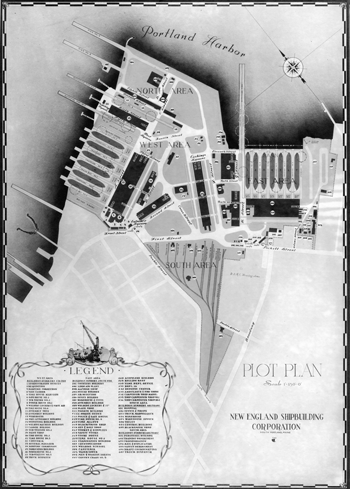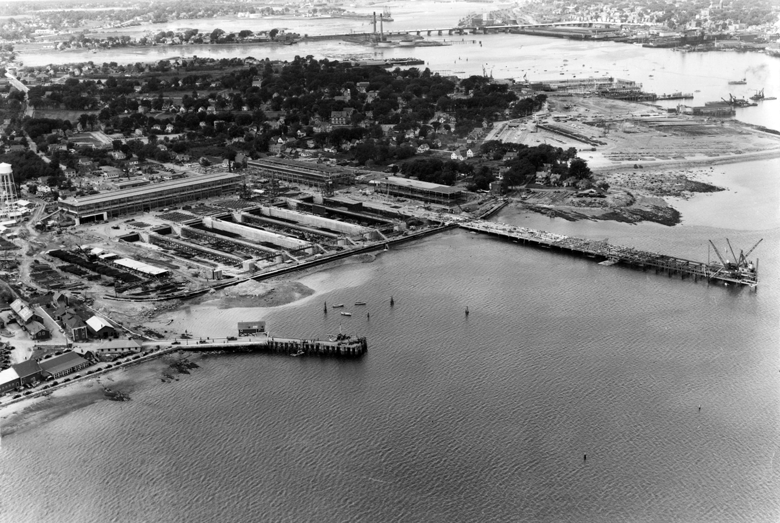
Maine can claim a lot of superlatives in terms of national shipbuilding. With about 20,000 vessels under its belt, Maine surpassed the output of states with major industrialized metropolitan areas for most of its history.
Many of the shipyards and boatyards today have been the site of active shipbuilding for decades, if not a century or more, with their own claims to fame in innovation, size, or speed. In contrast there are also builders of significance that lasted a surprisingly limited amount of time and had a huge impact, like the yard pictured here.
South Portland’s Cushing’s Point was home to a major government shipbuilding effort from 1941 to 1945. Neighborhoods and existing infrastructure were razed to build brand new, adjoining shipyards. Prior to the U.S. entry into World War II, Todd-Bath Iron Works was established to construct a fleet of 30 Ocean Class freighters for the British government—a much needed replenishment following German destruction of merchant ships.
Once the British contract was done, the neighboring yards merged to become New England Shipbuilding Corporation…
The U.S. quickly followed with its own emergency merchant shipbuilding program and the adjoining South Portland Shipbuilding Corporation was established to build freighters known as Liberty Ships. Once the British contract was done, the neighboring yards merged to become New England Shipbuilding Corporation and continued building Liberty ships—239 in total.
The image below from Maine Maritime Museum’s collections shows the early days of the Todd-Bath Iron Works site (also called the East Yard) with its neighbor (the West Yard) yet to be completed.
While 269 vessels is an impressive number, what is truly remarkable is the workforce that made it happen. Some 30,000 people were employed here at peak production. To put that in 2022 perspective—only three Maine cities have a population higher than 30,000 and Maine’s largest (single-location) employer is Bath Iron Works at just under 7,000 employees.
BIW’s World War II peak employment number rose to 12,000. The sudden influx of this number of shipyard workers would be a strain on most communities, but there were also thousands of soldiers and sailors stationed around Portland Harbor. The government rightfully deemed the area a “Congested War Production Area,” recognizing the need for housing, resources, and recreation and worked with community leaders to ease the burden.
Post-war, New England Shipbuilding Corporation did not seek work outside of its original government contracts and ceased operations in late 1945. The shipyard buildings were occupied by other companies over the years but were gradually torn down, the last in 2011. A minor exception is the South Portland Historical Society building. As a former residence, it predates the shipyard but was used as an office building.
Along with the Historical Society, Bug Light Park was once part of the West Yard. The park features a memorial to the Liberty ships that includes a sculptural representation of the bow section of a ship. Former West Yard property is also home to number of petroleum tanks. The East Yard property has seen more development and is currently home to marinas and related businesses.
Kelly Page is collections and library services manager for Maine Maritime Museum in Bath.
The museum is featuring “Looking for Winslow Homer” through Nov. 27. Explore resources and plan your visit at www.MaineMaritimeMuseum.org





